Top 6 Hikes in Ecuador for Active Travelers
Top 6 Hikes in Ecuador for Active Travelers
Despite its small size, Ecuador is a treasure trove of hidden hiking trails that remain largely under the radar. The country’s incredible diversity, from towering volcanoes and lush cloud forests to pristine coastlines and vast mountain ranges, makes it an ideal destination for hiking enthusiasts seeking varied landscapes and adventures.
Ecuador’s compact geography means that no matter where you are, you’re never far from a stunning trail. Whether you’re trekking up ancient volcanic slopes, wandering through biodiverse rainforests, or strolling along the coast with the Pacific Ocean as your backdrop, the hiking opportunities in Ecuador are both plentiful and breathtaking. Each trail offers its own unique blend of wildlife, scenery, and cultural experiences, making it a must-visit destination for hikers of all levels.
If you’re planning a hiking trip to Ecuador—and we highly recommend that you do—you’ll be spoiled for choice. Whether you’re looking for a challenging multi-day trek through the Andes or a relaxing day hike near the city, there’s a trail waiting for you.
Below, we’ve compiled a list of some of the best hikes in Ecuador, our favorites in the office and where we always return again and again.
- Pasochoa summit
Franziska’s favorite for its splendid views on the surrounding Andean peaks - Quilotoa crater lake
Who doesn’t love this hike around stunning turquois lake? - Summit Rucu Pichincha
Ramiro prefers this Quito’s local mountain with its easy cable car access - Morurco mountain loop in the Cotopaxi NP
For Veronica it’s a beautiful hike in the less frequented southern part of the National Park - Summit Illiniza North
At least once a year Monica climbs this steep and rocky summit - Piñan Trekking 4 days Escaping the modern world, we plunge into the rural life of this remote area. Juan, our trekking guide, suggests this beautiful trek.
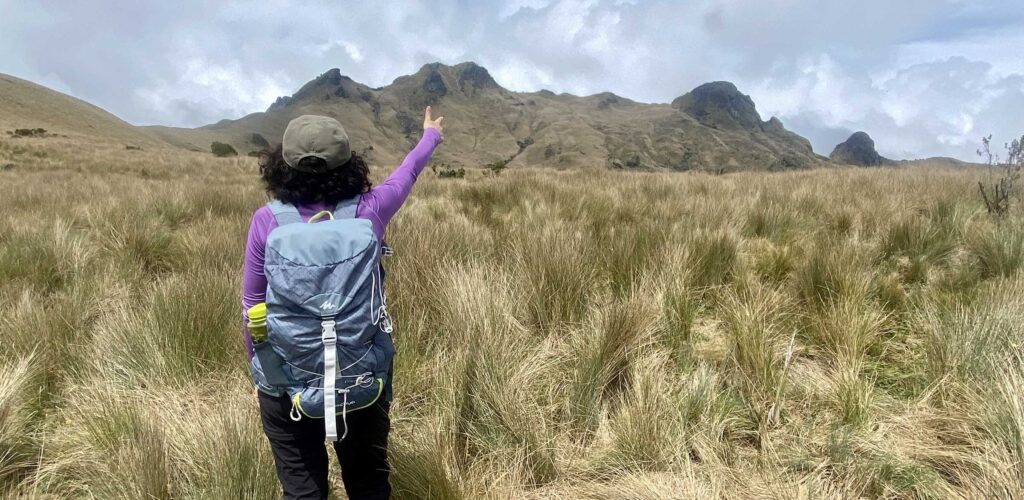
1. Summit Pasochoa
On of the best acclimatation hikes is the easy reachable summit of the extinct Pasochoa volcano. The caldera is horseshoe-shaped and is home to the Pasochoa Reserve, home to one of the last remnants of Andean Forest in the mountain range. Pasochoa is located just
south of Quito, on the central fault of the inter-Andean depression. It offers spectacular views to the surrounding snow-capped volcanoes and both Andean ranges going from North to the South.
One of the ascents to the summit is via the south-eastern side of the mountain through part of the Andean Forest and the grassy Páramo vegetation.
Travel time from Quito: 1,5 hours one way
Difficulty: easy to moderate
Hike: 5-6 hours
Difference in altitude +/- 790m / 2592ft, altitude 3,340 – 4,200m / 10,958 – 13,780ft
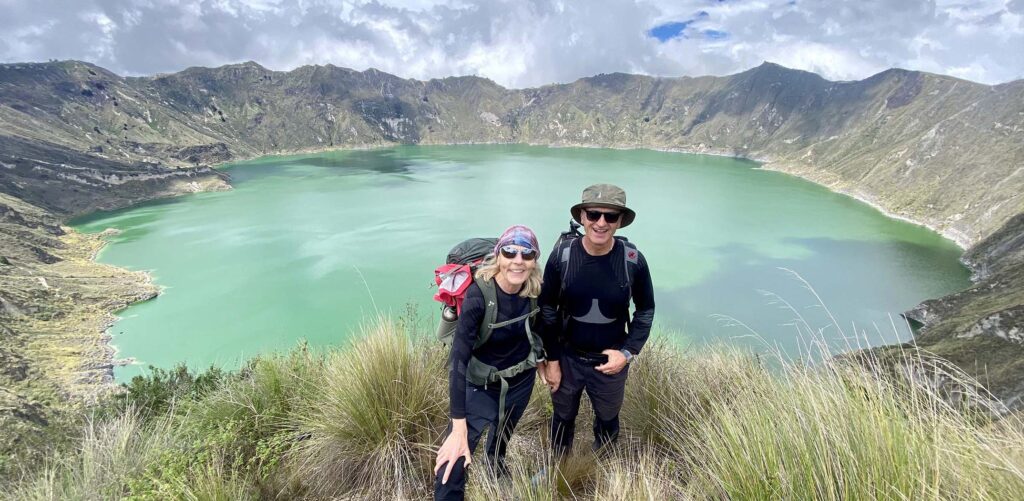
2. Quilotoa Crater Lake
Quilotoa, with its breathtaking volcanic crater lake, is a must-see destination in Ecuador. Known as Laguna Quilotoa, this mesmerizing blue-green lake is nestled in one of the most picturesque spots in the western Andes, making it a highlight of any trip to Ecuador, whether you’re staying for a week or longer. In addition to its striking beauty, Quilotoa marks the starting (or ending) point of the famous Quilotoa Loop trek, one of South America’s most iconic multi-day hikes. For those eager to explore the stunning landscape, Quilotoa offers a range of hiking opportunities that will leave you in awe of its natural splendor.
Quilotoa Crater Lake, formed in the caldera of an extinct volcano after a massive eruption in 1280 AD, is one of the most powerful volcanic events in the last 1,000 years. The eruption caused the volcanic cone to collapse, creating the crater, which later filled with
water. The lake is 250 meters (820 feet) deep at its deepest point. Quilotoa is part of the Illinizas Ecological Reserve, which also includes the Illinizas volcanic mountains, known for their challenging summits.
The Quilotoa Rim Hike offers a fantastic experience for those seeking more than just a descent into the crater. The views from the rim are stunning, providing panoramic sights of both Quilotoa Lake and the surrounding countryside. The well-marked trail has some inclines for most of the hike, making it physically demanding because of the altitude.
Travel time from Quito: 3 hours one way
Difficulty: easy to moderate
Hike: 4-5 hours Difference in altitude + /- 435m / 1430ft, altitude 3,692 – 3,870m / 12,113 – 12,697ft
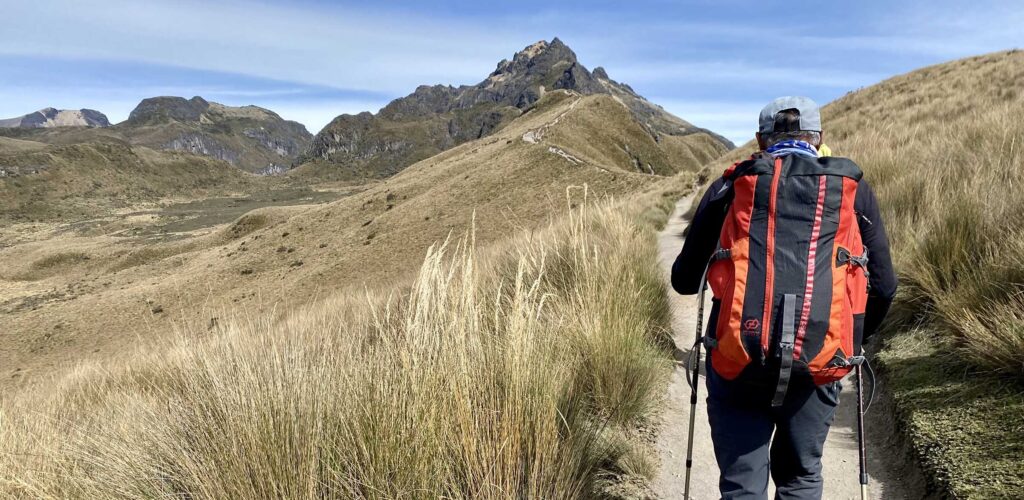
3. Summit Rucu Pichincha
Rucu Pichincha, an extinct stratovolcano, towers above Quito in the west and from its viewpoints at Cruz Loma you get a spectacular view over almost the whole city, with clear sky of four snowcapped volcanos and uncountable summits to the north, east, south and especially to the west.
The 15-minute cable cabin TelefériQo ride drops you off at Cruz Loma Station, from here it’s a fairly easy trek along winding dirt paths on the ridge, through Páramo grass and its special vegetation. As you get closer to the summit along the 10km trail you’ll hit a steep section of sand and rock, which you’ll need to scramble up, this is the hardest part before you get to its summit.
Travel time from Quito: 20 Min one way
Difficulty: easy to moderate
Hike: 5-6 hours
Difference in altitude +/- 760m / 2494ft, altitude 3,945 – 4,696m / 12,943 – 15,407ft
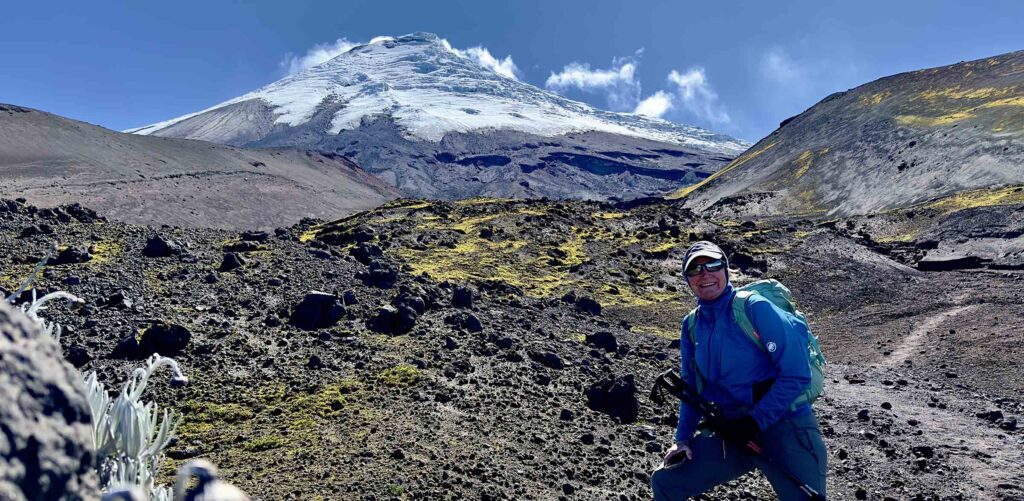
4. Morurco mountain loop
The Morurco, located at the southern base of Cotopaxi, is a volcanic mountain formed by ancient magma flows from Cotopaxi itself. This lesser-known hike offers stunning scenery, with panoramic views of Cotopaxi and the Quilindaña range to the east, and you may even spot condors soaring above.
The loop begins at Refugio Cara Sur, a small, privately-run mountain lodge. To take advantage of the clear morning weather, it’s best to stay overnight at the refuge and start the hike at sunrise, ideally with a guide familiar with the area’s valleys and ridges.
Travel time from Quito: 2 hours one way
Difficulty: moderate
Hike: 6 – 7 hours
Difference in altitude + /- 800m / 2625ft, altitude 3,930 – 4,690m / 12,894 – 15,388ft
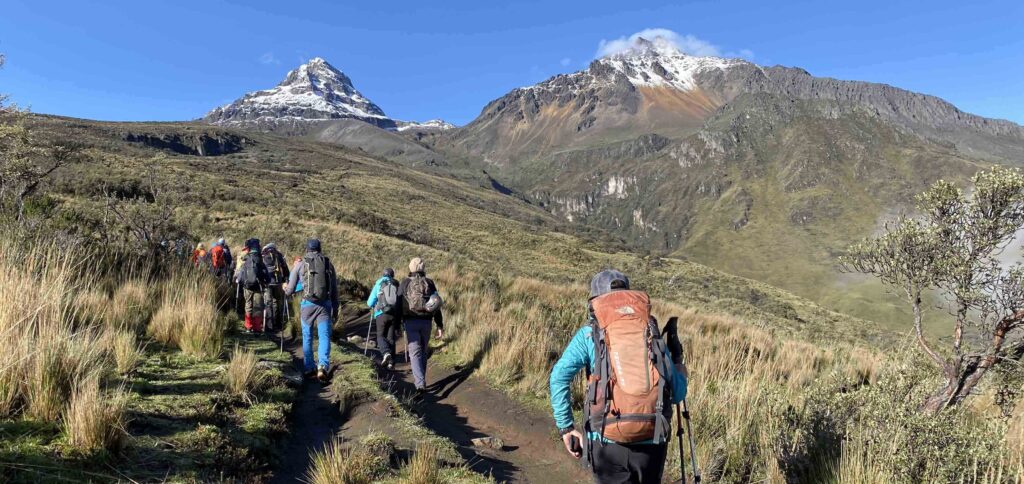
5. Summit Illiniza North
The Illinizas are twin volcanic peaks located in Cotopaxi province, within the Ecological Reserve of the same name. These majestic mountains, separated by a half-a-mile saddle, are among Ecuador’s highest. Illiniza Sur reaches 5,245m / 17.208ft and poses a tougher challenge due to its glaciers, while Illiniza Norte stands at 5,126m / 16,818ft and is considered a trekking peak, though it still requires climbing skills.
For Illiniza Norte, it’s recommended to hike with a certified guide, as the trail near the summit can be tricky. This hike is ideal for acclimatization before attempting higher peaks like Cotopaxi or Chimborazo. It can be completed in one day or as an overnight trip by staying at the basic refuge on the saddle, where you can enjoy stunning sunsets and sunrises over Ecuador’s “Avenue of Volcanoes.”
Travel time from Quito: 2 hours one way
Difficulty: moderate to hard
Hike: 8 – 10 hours
Difference in altitude + /- 1200m / 3937ft, altitude 3,980 – 5,126m / 13,056 – 16,818ft
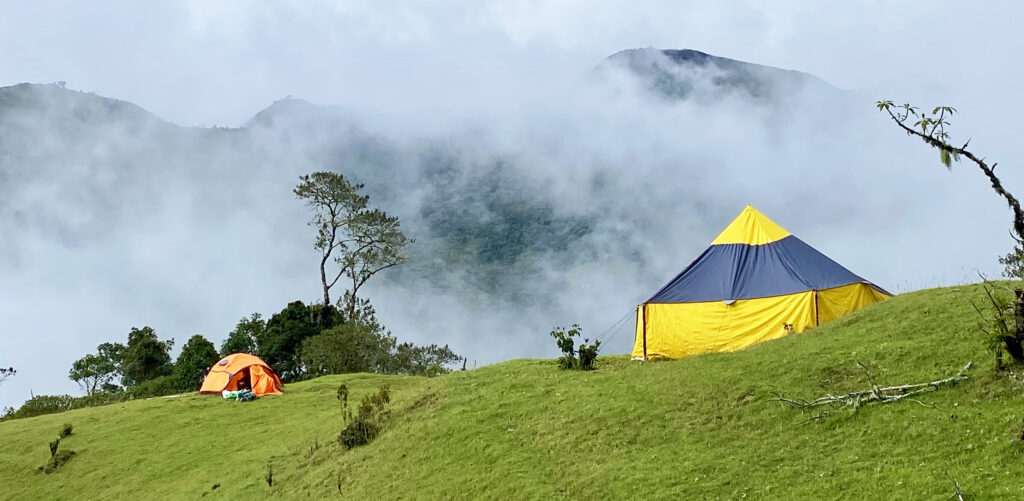
6. Piñan Trekking 4 days
This remote region northwest of Otavalo offers various trekking options, ranging from two to six days, taking you from the high-altitude Páramo vegetation down into the cloud forests of the Intag Valley. Trekkers can ascend Yanahurco’s summit for stunning views of the Northern Ecuadorian Andes. The isolated Kichwa village of Piñan, situated near a large mountain lake, provides a basic hut for accommodation, but camping is necessary in most parts of the area. An organized tour with muleteers and local guides is highly recommended, as they know the best trails and ideal camping spots.
Travel time from Quito: 4 hours one way
Difficulty: moderate to hard

